Eyewitness Accounts
Round-ups and Mass Murders
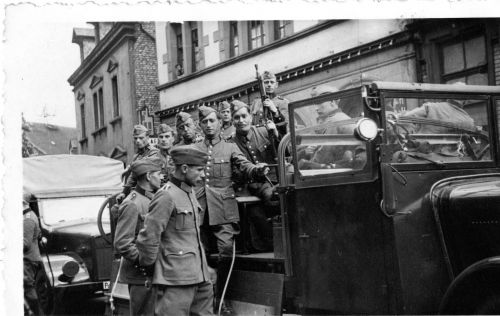
An Einsatzgruppen Unit arrives in a town (Chris Webb Archives)
Felix Landau - Diary
Lemberg,3 July 1941
On Monday, 30 June 1941, after a sleepless night I volunteered for a number of reasons to join an EK (Einsatzkommando). By 9 o'clock, I had heard that I had been accepted. At 4.00 pm. on 2 July 1941, we arrived in Lemberg. First impression: Warsaw harmless in comparison. Shortly after our arrival the first Jews were shot by us. As usual a few of the new officers became megalomaniacs, they really enter into the role wholeheartedly. We took over another military school in the Bolshevik quarter. Here the Russians must have been caught in their sleep.
Lemberg, 5 July 1941
One hour later, at 5 in the morning, a further thirty-two Poles, members of the intelligentsia and Resistance, were shot about two hundred meters from our quarters, after they had dug their own grave. One of them simply would not die. The first layer of sand had already been thrown on the first group when a hand emerged from out of the sand, waved and pointed to a place, presumably his heart. A couple more shots rang out, then someone shouted - in fact the Pole himself- 'Shoot faster!' What is a human being?
During the afternoon some three hundred more Jews and Poles were finished off. In the evening we went into town just for an hour. There we saw things that are almost impossible to describe. We drove past a prison. You could tell already from a few streets away that a lot of killing had taken place here. We wanted to go and visit it but did not have any gas masks with us, so it was impossible to enter the rooms in the cellar or the cells. Then we set off back to our quarters.
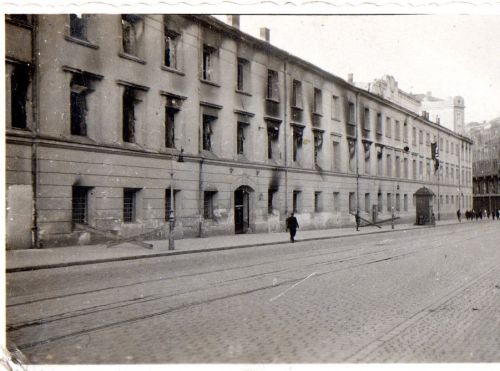
Lemberg - GPU Prison (Chris Webb Private Archive)
At a street corner we saw some Jews covered in sand from head to foot. We looked at one another. We were all thinking the same thing. These Jews must have crawled out of the grave where the executed are buried. We stopped a Jew who was unsteady on his feet. We were wrong. The Ukrainians had taken some Jews up to the former GPU Citadel. These Jews had apparently helped the GPU persecute the Germans and Ukrainians. They had rounded up 800 Jews there, who were also supposed to be shot by us tomorrow. They had now released them.
We continued going along the road. There were hundreds of Jews walking along the street with blood pouring down their faces, holes in their heads, their hands broken and their eyes hanging out of their sockets. They were covered in blood. Some of them were carrying others who had collapsed. We went to the Citadel; there we saw things that few people have ever seen. At the entrance of the Citadel there were soldiers standing guard. They were holding clubs as thick as a man's wrist, and were lashing out and hitting anyone who crossed their path. The Jews were pouring out of the entrance. There were rows of Jews lying one on top of the other like pigs whimpering horribly. The Jews kept streaming out of the Citadel completely covered in blood. We stopped and tried to see who was in charge of the Kommando. Nobody. Someone had let the Jews go. They were just being hit out of rage and hatred.
Nothing against that - only they should not let the Jews walk about in such a state. Finally we learned from the soldiers standing there that they had just visited some comrades of theirs, airmen in fact, in hospital in Lemberg, who had been brutally injured. They'd had their fingernails torn out, ears cut off and also their eyes gouged out. This explained their actions: perfectly understandable.
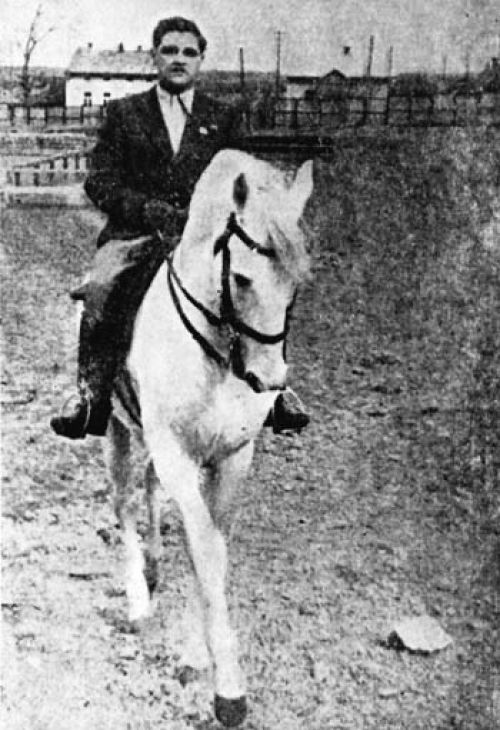
Felix Landau in Drohobycz, (Yad Vashem)
Drohobycz, 12 July 1941
At 6.00 in the morning I was suddenly awoken from a deep sleep. Report for an execution. Fine, so I'll just play executioner and then gravedigger, why not? Isn't it strange, you love battle and then have to shoot defenceless people. Twenty-three had to be shot, amongst them the two above-mentioned women. They are unbelievable. They even refused to accept a glass of water from us. I was detailed as marksman and had to shoot any runaways.
We drove one kilometre along the road out of town and then turned right into a wood. There were only six of us at that point and we had to find a suitable spot to shoot and bury them. After a few minutes we found a place. The death candidates assembled with shovels to dig their own graves. Two of them were weeping. The others certainly have incredible courage. What on earth is running through their minds during those moments? I think that each of them harbours a small hope that somehow he wont be shot. The death candidates are organised into three shifts as there are not many shovels. Strange, I am completely unmoved. No pity, nothing.......
And here I am today, a survivor standing in front of others in order to shoot them. Slowly the hole gets bigger and bigger; two of them are crying continuously. I keep them digging longer and longer; they don't think so much when they're digging. While they are working they are in fact calmer. Valuables, watches and money, are put into a pile.
When all of them have been brought to stand next to one another on a stretch of open ground, the two women are lined up at one end of the grave ready to be shot first. Two men had already been shot in the bushes by our Kriminalkommissar...... I did not see this as I had to keep my eye on the others. As the women walked to the grave, they were completely composed. They turned round. Six of us had to shoot them. The job was assigned thus: three at the heart, three at the head. I took the heart. The shots were fired and the brains whizzed through the air. Two in the head was too much. They almost tear it off. Almost all of them fell to the ground without a sound. Only with two of them it didn't work. They screamed and whimpered for a long time. Revolvers were no use. The two of us who were shooting together had no failures. The penultimate group had to throw those who had already been shot into the mass grave then line up and fall in themselves. The last two had to place themselves at the front edge of the grave so that they would fall in at just the right spot. Then a few bodies were rearranged with a pickaxe and after that we began the grave digging work.
Erwin Bingel
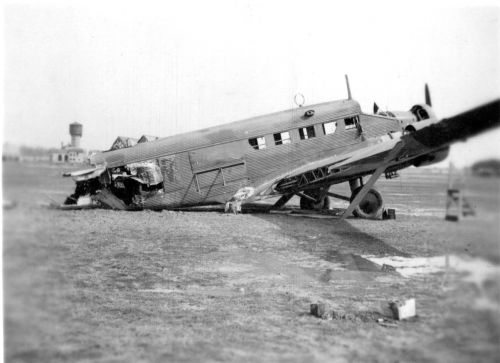
Uman Flugplatz (Tall Trees Archive)
Uman, September 16, 1942
Lieutenant Erwin Bingel, a German Army officer, whilst a prisoner-of-war set down his recollections of what he witnessed in Uman in Russia. On September 15, 1941, he was ordered to report to the commander of the town of Uman, in occupied Russia, and ordered to set up guards on all railways in the area, around the airport. He did so, discovering, as he put his men in place, that ditches had just been dug in the square in front of the airport. As dawn broke on September 16, 1941, Lieutenant Erwin Bingel's men were in place and then they saw a crowd of people being brought to the ditches in front of the airfield.
Lieutenant Erwin Bingel recalled what happened next:
When the people had crowded into the square in front of the airport, a few trucks drove up from the direction of the town. From these vehicles a troop of field gendarmes alighted, and were immediately led aside. A number of tables was then unloaded from one of the trucks, and placed in a line at distances from each other. Meanwhile, a few more trucks with Ukrainian militiamen commanded by SS had arrived. These militiamen had work tools with them and one of their trucks also carried chloride of lime. The trucks now drove alongside these ditches and the men on it unloaded six to eight sacks of chloride of lime at intervals of fifteen to twenty metres.
In the meantime, a number of transport planes- Junker Ju 52's had landed at the airport. Out of these stepped several units of SS soldiers who, having fallen in, marched up to the Field Gendarmerie unit, subsequently taking up positions alongside it. As could be discerned from the distance, the two units were obviously being sworn in. I was then informed by my interpreter (who was Jewish- which in fact, however, was known only to me personally) that he had learned that the people had been posted in the streets of Uman and which had been given the widest publicity throughout Uman sub-district by the Ukrainian militia......
The result of this proclamation was, of course, that all persons concerned appeared as ordered. This relatively harmless summons, it was thought could be connected in some way or other with the preparations we were observing. It was because we took the matter so lightly that we were all the more horrified at what we witnessed during the next few hours.
One row of Jews was ordered to move forward and was then allocated to the different tables, where they had to undress completely and hand over everything they wore and carried. Some still carried jewellery which they had to put on the table. Then, having taken off all their clothes, they were made to stand in line in front of the ditches, irrespective of their sex. The commando's then marched in behind the line and began to perform the inhuman acts, the horror of which is now known to the whole world.
With automatic pistols and 0.8 pistols, these men mowed down the line with such zealous intent that one could have supposed this activity to have been their life-work. Even women carrying children a fortnight to three weeks old, sucking at their breasts, were not spared this horrible ordeal. Nor were mothers spared the terrible sight of their children being gripped by their little legs and put to death with one stroke of the pistol-butt or club, thereafter to be thrown on the heap of human bodies in the ditch, some of which were not quite dead. Not before these mothers had been exposed to this worst of all tortures did they receive the bullet that released them from this sight.
The people in the first row thus having been killed in the most inhuman manner, those of the second row were now ordered to step forward. The men in this row were now ordered to step out and were handled shovels with which to heap chloride of lime upon the still partly moving bodies in the ditch. Thereafter, they returned to the tables and undressed. After that they had to set out on the same last walk as their murdered brethren, with one exception - this time the men of the alternative firing squad surpassed each other in cruelty, lest they lag behind their predecessors.
The air resounded with the cries of children and the tortured. With senses numbed by what had happened, one could not help thinking of wives and children back home who believed they had good reason to be proud of their husbands and fathers, who, they thought were fighting heroically in the ranks of the German army on behalf of the Fatherland, whilst the so-called Elite troop, always referred to as unique, perpetrated the most horrible acts of cruelty in the honourable uniform of a nation.
Lieutenant Erwin Bingel, and his men witnessed more massacres in Vinnitsa during September 1942, and he recalled:
In the morning at 10.15, wild shooting and terrible human cries reached our ears. At first I failed to grasp what was taking place, but when I approached the window from which I had a broad view over the whole of the town park, the following spectacle unfolded before my ears and those of my men who, alerted by the tumult, had meanwhile gathered in my room.
Ukrainian militia on horseback, armed with pistols, rifles and long straight cavalry swords, were riding wildly inside and around the town park. As far as we could make out, they were driving people along before their horses - men, women, and children. A shower of bullets was then fired at this human mass. Those not hit outright were struck down with the swords.
Like some ghastly apparition, this horde of Ukrainians, let loose and commanded by SS officers, trampled savagely over human bodies, ruthlessly killing innocent children, mothers and old people whose only crime was that they had escaped the great mass murder, so as eventually to be shot or beaten to death like wild animals.
Hermann Graebe
Hermann Graebe, a German engineer witnessed the round-up of several thousand Jews in the Rowne Ghetto, in the Volhynnia, on July 13, 1942 and he recalled after the war:
On the evening of this day, I drove to Rowne and posted myself with Fritz Einsporn in front of the house in the Bahnhofstrasse in which the Jewish workers of my firm slept. Shortly after 22.00 the ghetto was encircled by a large SS detachment and about three times as many members of the Ukrainian militia. Then the electric arc-lights which had been erected in and around the ghetto were switched on. SS and militia squads of four to six men entered or at least tried to enter the houses. Where the doors and windows were closed and the inhabitants did not open at the knocking, the SS men and the militia broke the windows, forced the doors with beams and crowbars, and entered the houses. The people living there were driven on to the street just as they were, regardless of whether they were dressed or in bed.
Since the Jews in most cases refused to leave their houses and resisted, the SS and militia applied force. They finally succeeded, with strokes of the whip, kicks and blows, and rifle butts, in clearing the houses. The people were driven out of their houses in such haste that small children in bed had been left behind in several instances.
In the streets women cried out for their children and children for their parents. That did not prevent the SS from driving the people along the road at running pace, and hitting them, until they reached a waiting freight train. Carriage after carriage was filled, and the screaming of women and children and the cracking of whips and rifle shots resounded unceasingly. Since several families or groups had barricaded themselves in especially strong buildings and the doors could not be forced with crowbars or beams, the doors were now blown open with hand grenades.
Since the ghetto was near the railroad tracks in Rowne, the younger people tried to get across the tracks and over a small river to get away from the ghetto area. As this stretch of country was beyond the range of the electric lights, it was illuminated by small rockets. All through the night these beaten, hounded and wounded people moved along the lighted streets. Women carried their dead children in their arms, children pulled and dragged their dead parents by their arms and legs down the road toward the train. Again and again the cries, 'Open the door!' echoed through the ghetto.
The ghetto in Rowne was liquidated in July 1942, when the Jews were taken by train to a forest near Kostopol where they were murdered.
Siegfried Schuchardt
Siegfried Schuchardt was interrogated on May 14, 1962 regarding the use of gas-vans:
The gassing van came from Simferopol. There wasn't one stationed in Kertsch. I no longer remember whether it was sent to us from headquarters, or whether it was requested by me on a trip to Simferopol when I was informed of its existence and the orders that governed its use. Either way, it arrived one day from Simferopol and stopped outside the former NKVD building to load up prisoners which it then took to anti-tank ditches in the environs of the industrial quarter.
The prisoners were essentially people identified as partisans or agents. There were I believe, also some women among them. No child was gassed; I am completely sure that no child was gassed during the second occupation of Kertsch. As for the request for an estimate of the number of people who were gassed in vans, I can give only an approximate estimate of fifty or so, as the van was filled twice and twenty-five people were, I reckon, loaded into it each time.
I am sure that the delinquents were not forced to get undressed before they got into the van. The cries of the prisoners when the doors were closed and the van set off are still ringing in my ears. This action with the gas van was probably one of the hardest things I ever had to live through. I was not present when the van was unloaded into the anti-tank ditch. So I can't say who carried this out or how it was done. However, I do know that the men who took part in such actions said they would rather have shot those people than be on duty during the use and emptying of the van.
Julius Bauer
Julius Bauer was the driver of Paul Blobel, the Einsatzgruppen Commander 4a, part of Einsatzgruppe C, who organised the infamous Babi Yar massacre in Kiev, on September 29 and 30, 1941, where 33,771 Jewish men, women and children were slaughtered by his commando. Julius Bauer testified after the war:
The use of the gas vans was the most horrible thing I have ever seen. I saw people being led into the vans and the doors closed. Then the van drove off. I had to drive Blobel to the place where the gas van was unloaded. The back doors of the van were opened, and the bodies that had not fallen out when the doors were opened were unloaded by Jews who were still alive. The bodies were covered with vomit and excrement. It was a terrible sight. Blobel looked , then he looked away, and we drove off. On such occasions Blobel always drank schnapps, sometimes even in the car.
Wilhelm Findeisen
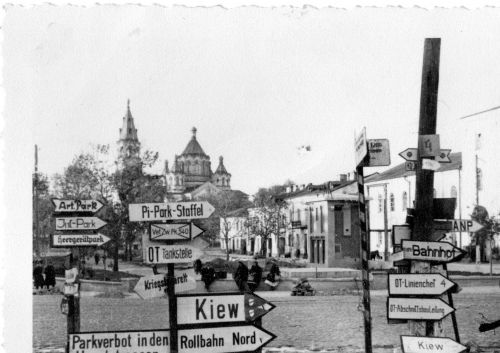
Kiev under German Occupation (Chris Webb Private Archive)
I was told that the whole operation and the van itself were secret. It was expressly forbidden to photograph the vans and I was ordered not to let anyone near the van. I then joined Sonderkommando 4 in Einsatzgruppe C. The van was not used immediately when we arrived in Kiev. When we first arrived they were only carrying out isolated actions. Being a driver, I had nothing to do with these isolated actions. One evening several officers appeared and ordered certain people to go with them. They went into a private flat where they picked up a professor and his daughter. These people were then taken to a spot close to a piece of open land where a grave was dug. The officers, then gave orders for these two people to be shot. One of the officers said to me, 'Findeisen, shoot these people in the neck.' I refused to do this as did the other men. The girl must have been about eighteen or nineteen. The officer shot the people himself, as the others refused. He swore at us and said we were cowards, but apart from that he did not do anything else.
The gas-van was used for the first time in Kiev. My job was simply to drive the van. The van was loaded at headquarters. About forty people were loaded in, men, women and children. I then had to tell the people they were being taken away for work detail. Some steps were put against the van and the people were pushed in. Then the door was bolted and the tube connected. I drove through the town and then out to the anti-tank ditches, where the vehicle was opened. This was done by prisoners. The bodies were thrown in the anti-tank ditches.
Petras Zelionka
Petras Zelionka, served as a Lithuanian auxiliary police member. He was a guard at Fort VII in Kaunus, and then as a member of an Einsatzgruppen took part in the murder of Jews in a number of locations such as Babtai, Joniskis and Vikija. He was interviewed as part of the Television programme, 'The Nazis. A Warning From History - Part 5 - The Road to Trebkinka.'
Maybe you could call them volunteers- they were certainly given more vodka. They drank it and then everyone became braver. We would shoot them, give them up as lost and that was it. Today all this is very difficult to explain. Whether to shoot or not to shoot. I do not know. The others did it because of their anger - they thought the Jews were very selfish. What can I say? This is a tragedy, a big tragedy.
How should I put it to you? How can I explain? Its a kind of curiosity. You just pull the trigger, he falls and that's it. They can accuse me if they want. I was given a 20-year sentence and I served 20-years.
Sara Menkes
Abba Kovner a Jewish teacher and partisan in Vilna, who survived the Holocaust testified during Session27, May 4, 1961, at the Adolf Eichmann trial in Jerusalem, about the recollections of Sara Menkes, who was rescued from the killing pits at Ponary, just outside Vilna, and who had described the murder of one of his former pupils, Serna Morgenstern, the daughter of Professor Michal Morgenstern:
Sara Menkes reported at the edge of the pit....
.... they were lined up; they were told to undress; they undressed and stood only in their undergarments and there was the line of the Einsatzgruppen men - and an officer came out, he looked at the row of women and he looked at this Serna Morgenstern; she had wonderful eyes, a tall girl, long -braided hair - he looked at her searchingly for a long time and then he smiled and said, 'Take a step forward.' She was dazed, as all of them were. No one wept anymore, no one asked for anything; they must have been paralysed and she was so paralysed she did not step forward and he repeated the order and asked, 'Hey, don't you want to live? You are so beautiful. I tell you to take one step forward.'
So she took that step forward and he told her, 'What a pity to bury such a beauty under the earth. Go, but don't look backward. There is the street . You know that boulevard, you just follow that.' She hesitated for a moment and then she started marching, and the rest, Sara Menkes told me, 'We looked at her with our eyes - I don't know whether it was only terror or jealousy, envy too, as she walked slowly step by step and then the officer whipped out his revolver and shot her in the back.' Must I tell more?
In a post-war book by Abraham Sutzkever it was claimed that the officer who murdered Serna Morgenstern was Hauptsturmführer Martin Weiss, a Kriminalsekretar in the Vilna Gestapo.
Halina Jankoska
Halina Jankoska, the daughter of a railway gateman still lives in a house in the Ponary Forest, on the outskirts of Vilnius, and witnessed the mass murder of Jews there. She was interviewed as part of the French documentary programme on the Einsatzgruppen. This is what she recalled:
They shot Jews, we saw everything, we watched from here. Once this guy Sinkewicz picked up clothes. He got caught by the Lithuanians. The killers. They killed him too like a Jew. Schilnikas was in charge here. Once a child was playing in the sand by the pit. Schilnikas whipped out his gun and killed him. A tiny little child.
The largest batch of Jews they killed was 10,000. The line stretched all the way to Dobraja Rada. They had to bring in more 'horse-slaughterers' to help. They slaughtered people. That's what my mother called them. We did too. It's a butchery word for those who kill horses. But once she used the word it stuck. We called them 'horse-slaughterers' from then on. Only in our family.
Regina Jablonska
Regina Jablonska was hired as a cook for the Einsatzgruppen members in Ponary Forest. She was also interviewed as part of the French documentary programme on the Einsatzgruppen. This is her account:
Every day a dozen of the gunners, Lithuanians came to lunch. We were wondering, What kind of job is this? Once this Lithuanian strutted in, in his uniform. He had rings on his fingers. He said, 'It's dull today. There's nobody to shoot.' I didn't see the shootings, I just heard the screams. If they were firing during lunch, when the wind came from the west, it carried these cries. Very faintly, from far away. And gunfire, over and over.
From the window of these houses, we'd see the car drive up. A German with eyeglasses named Weiss sat up front with the driver. He opened the door, and took them out, herded them along, and then we heard shots. Everyone knew what was going on.
Anatoly Lipinski
Anatoly Lipinski played the accordion for the killers at Ponary every day. He was interviewed as part of the French documentary programme on the Einsatzgruppen. This is what he recalled:
The killers were always boasting, especially when drunk, ' Look what I got from the bodies,' one would say. And he'd take a handful of gold watches out of his pocket. The other would reply, 'Well, I've got plenty of rings.' Another would show a little bag of gold teeth, he'd ripped out, from the jaws of corpses that had been shot. Or maybe from the living. I'm not sure, I wasn't there.
They showed each other their loot, joking, boasting........ I saw a Jew-girl, a teenager with a cute arse, so I raped her, one of the killers said. How did I feel around them? My soul didn't like them. But if I hadn't gone, they'd have hurt my parents, so I went. They made me play. They sat there laughing. They treated me well. They fed me and even gave me bonbons. Once, one of them brought me a pair of shoes. I was practically barefoot. He'd taken the shoes off a body.
Inna Evguenieva
Inna Evguenieva was a Ukrainian eyewitness to the Babi Yar massacre in September 1941. She lived at I Babi Yar Street overlooking the ravine, where the Jews were murdered by the Einsatzgruppen. She gave her account:
Only old men, women and children remained. An immense crowd of people, impossible for me to count, was brought here. The line was endless. So was the automatic rifle fire and shots from a machine -gun. When we went to bed at home, our heads were full of the sound of shooting. It's all impossible to forget.
I could see everything. The ravine was by my house.... We saw it all. They were led to the ravine's sandy part, then stripped naked. For some reason they were also beaten. They were made to lie down and beaten with whips.. a rubber thing. If someone refused to undress, they'd shake him and tear off his clothes. They'd grab him and throw him in the ravine.
I remember a group of four or five girls who absolutely refused to undress. The Germans pulled on their clothing, 'Undress!' they shrieked. And they refused. They attacked the Germans. We could hear. The Germans cursed them and shot them there and then, fully dressed. They died with their clothes on. They were dragged to the ravine and thrown in.
Others were docile, they didn't protest. I remember, that evening, the clothing piled up. Coats, little souvenirs. It was all loaded into bins and hauled away. We could see the outlines of the bodies. At the end of the day, they built a circular sand -dyke. In its centre, we could see a black pool of blood and fat. A lake of black liquid. So many people had been killed. The wounded bled, you could see the blood through the sand.
The thing that struck me then was the excellent Ukrainian spoken by the Germans. When I went home, I asked my grandmother, 'Why, I understand all that they said, the curses, the insults..... they were Ukrainians, that's why.
They were horrible. Such cruelty is rare. They took babies, they didn't kill them. They shook their blankets until the babies fell into the ravine. It turns out people could be like that. They were anti-Soviet. Later, I saw a film saying they'd been hurt and wanted revenge. Revenge against children? The women? They were innocent. They weren't the guilty ones. They took revenge on these thousands of people, 100,000 or 150,000 people died here.
They could have settled the score between themselves, not by killing a peaceful people. Today, if a person takes one life, he is judged. But for taking 150,000 lives, which punishment should be found?
In the beginning, the killing was daily, but six months later, it was only twice a week. There were specific days: Tuesdays and Thursdays or Fridays. I don't remember which, Thursday's or Friday's? On these days, we weren't allowed to walk here.
Margers Vestermans
Margers Vestermans a survivor of the Riga ghetto recalled:
At work we saw Soviet Prisoners of War, often we worked together. We were building railroads, or unloaded ships in the harbour. We were forbidden to speak to them, but we would do it anyway. They told us, 'We're digging graves for you!' The news spread quickly in the ghetto. We said, 'the POW's don't understand - the graves are for them!' They warned us, but we couldn't believe it.
Jeckeln had already elaborated the plan. He had calculated that it took an hour to kill 1,000 people. To bring them in, have them undress, funnel them through this corridor called a 'schlauch.' People had to run between two lines of police, who were clubbing them. And at the end was a big pit, dug for them. Can a person believe that killers will force their victims to lie down on the still-warm, bloody corpses of others? Face down, with killers walking on their backs, shooting them dead, one after another! Try to imagine the scene. 'Apocalyptic' may be too weak a term.
The Arajs Kommando took orders directly from the German SD. It was a Latvian SD division. The Germans used them of course, but they weren't the main gunners. They only shot the people who tried to escape, or who resisted going through the 'Schlauch.'
Edward Anders
Edward Anders a survivor of the massacre at Liepaja, in Latvia, interviewed in the French documentary programme on the Einsatzgruppen. This is what he recalled:
There were orders from Himmler that he wanted drastically to reduce the number of Jews, and so in Riga, of course, there was a notorious Rumbala massacre, two massacres. And in the middle of December it was the turn of Liepaja. They had killed a little less than half of the Jews by November. And then they rounded up another 2,700 or so in December and shot them also. And that left about a 1,000. And after some further killings, there were 800 left that went into the ghetto. And this time in December it was also my time.
Edward Anders was able to escape the massacre on Skede Beach, thanks to his mother and Latvian friends who were able to bribe a Nazi officer to provide him with a false certificate showing Aryan descent and he continued:
They had three execution squads, one German, two Latvian. One of the Latvians was in the Latvian SD unit, the other one was just ordinary police, that had been ordered to escort the Jews to this place, Schtit. But then when they arrived there, their lieutenant told them, 'You'll have to shoot!' So they had rifles and then they counted out groups of ten Jews, and there were twenty marksmen. Each of them had to.... each of the victims got two bullets.
And then there came the next group, it was all quite efficiently organised. And there exists a dozen pictures of those executions, which a German SS man had photographed, and a Jew working in the Security Police, as an electrician, noticed that roll of film in this SS man's room, where he was supposed to do some electrical work there. And so he quickly arranged to have the film copied and then put it back.
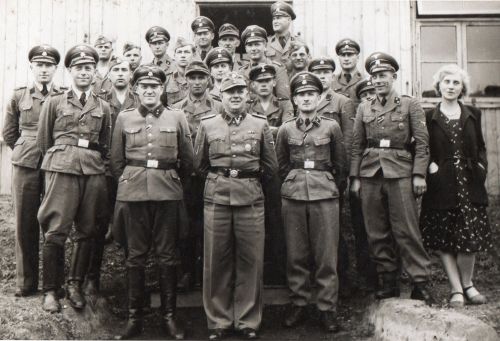
An SD Unit in Russia (Chris Webb Private Archives)
Sources
W. Dressen, E.Klee, V.Reiss, Those Were the Days, published by Hamish Hamilton, London 1991
M.Gilbert, The Holocaust – The Jewish Tragedy, published by Collins London 1986
C. Ingrao, Believe and Destroy, Polity Press, 2013
French. L. MacLean, The Field Men, Schiffer Military History, Atglen, PA 1999
The Nazis. A Warning From History -Part 5 - 'The Road to Treblinka, BBC 1997
Einsatzgruppen, PBS Television Documentary 2009
www. Jewishgen
Heather and Mark Spyrakis
Photographs: Chris Webb Private Archive, Yad Vashem, Tall Trees Archive
© Holocaust Historical Society 2019

